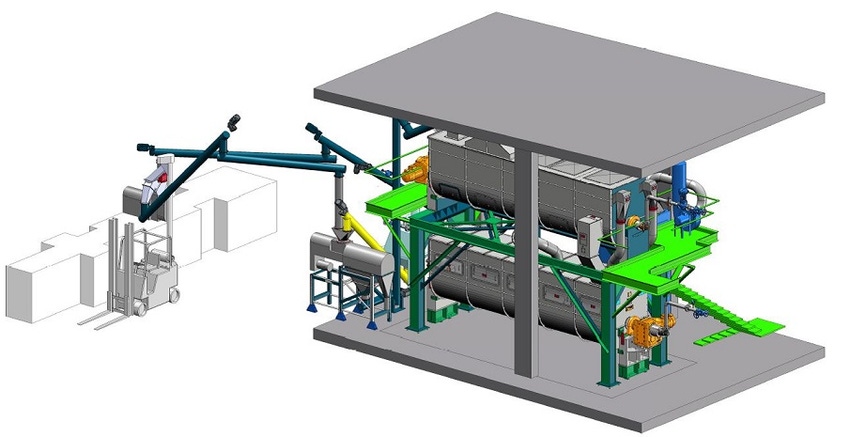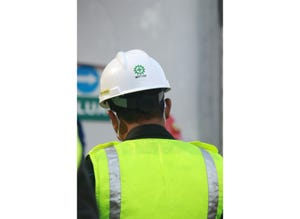Protecting Corn Starch Processes Against Combustible Dust Explosion Risks
December 5, 2019

REMBE Inc. and its exclusive California sales rep, WES-CO Industries, were contacted by a specialty candy and nutraceuticals manufacturer in California to design-build an explosion protection system for a new corn starch drying process the company was looking to install. Considering the impact of moisture content in the corn starch on the end product, the customer was keen on preventing any possibility of contamination and ensuring a low cost of ownership in the final solution. After a comparative review of an active solution with chemical suppression and a passive solution with flameless venting, a decision was made to proceed with the latter solution.
Corn starch is one of the most commonly used products in many processes ranging from food and pharmaceutical to wood processing applications. Typically, corn starch is an ST1 combustible dust, but due to the fine particle size it is one of the easiest products to ignite.
This corn starch drying process (Fig.1) involves conveying starch from an unloading station via mechanical conveyors (a series of rigid screw conveyors) to a starch dryer. The starch dryer then discharges the product via gravity to the starch cooler located directly below it. The two enclosures are identical in geometry and volume, which allowed for explosion protection per NFPA 68, 2018 section 8.12:
8.12* Deflagration Venting of Enclosures Interconnected with Pipelines.
8.12.1* For interconnecting pipelines with inside diameters no greater than 0.3 m (1 ft) and lengths no greater than 6 m (20 ft), the following requirements shall apply [104]:
(1) The venting device for the enclosure shall be designed for Pstat < 0.2 bar-g.
(2) Enclosures of volumes within 10 percent of each other shall be vented as determined by Equation 8.2.2 and Equation 8.2.3.
(3) If enclosures have volumes that differ by more than 10 percent, the vents for both enclosures shall be designed as if Pred were equal to 1 bar-g or less. The enclosure shall be designed with Pes equal to a minimum of 2 bar-g.
(4) If it is not possible to vent the enclosure with the smaller volume in accordance with this standard, the smaller enclosure shall be designed for the maximum deflagration pressure, Pmax, and the vent area of the larger enclosure with the larger volume shall be doubled.
(5) The larger enclosure shall be vented or otherwise protected as described in NFPA 69 in order for the deflagration venting of smaller enclosures to be effective.
8.12.2* For enclosures outside the scope of 8.12.1, explosion isolation or suppression shall be provided in accordance with NFPA 69 unless a documented risk assessment acceptable to the authority having jurisdiction demonstrates that increased vent area prevents enclosure failure
This guideline helped eliminate the need for explosion isolation between the two enclosures. The starch dryer in this process utilizes steam to dry off the corn starch. Due to the open volume available in the dryer enclosure, there was a significant risk of ignition once the product is discharged from the mechanical conveyor.
Q-Box flameless vents are ideal for such applications because these passive devices require minimal maintenance and can be mounted on the top of the enclosure without affecting the functionality of the dryer at all. The Q-Box flameless venting system guarantees safe explosion venting in working areas since flames are instantly quenched inside the Q-Box by efficient cooling. The burst pressure of the explosion panel on the Q-Box is only 1.45 psi, which protects the dryer against deformation during a deflagration event. Even in the event of a process anomaly causing over pressurization the explosion panel--if ruptured--can be replaced easily without requiring any additional cleanup or significant downtime.
This proved to be the key in making the decision for a completely passive explosion protection solution overall. The alternative would have been an active chemical suppression system that--requiring quarterly and annual inspections--would have significantly increased the cost of ownership of the equipment. It is also important to note that in certain cases a combination of active and passive systems (aka a hybrid system) is possible but the costs of quarterly/annual inspections must still be considered.
If triggered, an active chemical suppression system would require replacement of bottles and significant cleanup of the interconnected enclosures. This was one of the concerns presented by the customer considering the sanitary requirements in the process.
The dried corn starch is gravity transferred from the dryer to the starch cooler assembly. The starch cooler utilizes chilled water for the process. Considering the lower moisture content in the cooler and the high explosibility value of corn starch, explosion protection with Q-Box flameless vents was utilized (Fig. 2).
To remove fugitive dust and moisture from the process, a dust collector was included in the system. The dust collector is equipped with a VFD to facilitate removal of fumes/vapors at a low frequency. Since the associated dust collector presents an explosion hazard, a Q-Box flameless vent is installed on the unit (Fig 3) as well.
From the dryer, the product is mechanically transferred to a storage silo. The storage silo is approximately 10 cu m in volume and is equipped with a Q-Box flameless vent as well (Figure 4). The mechanical conveyors for in-feed and discharge act as a material choke, due to the nature of operation, eliminating the need for isolation between enclosures.
The comprehensive review with client participation at the front end of this project ensured REMBE Inc. would be able to provide a complete and accurate solution. In fact, the completely passive explosion protection system provided exceeded the customer’s expectations, providing a safe, cost-effective solution well within budgets that would prevent contamination and be easy to maintain.
Abhi Bhargava, is regional sales manager, REMBE Inc. In addition to manufacturing a full line of combustible dust explosion safety systems, REMBE provides combustible dust analysis, process analysis, training, and support, with offices around the world. For more information, email [email protected], call 704-716-7022, or visit www.rembe.us.
Established 1923, WES-CO Industries is a design-build industrial contractor with a specialty practice in dust collection, industrial ventilation, and explosion protection. Inquiries for explosion protection solutions and other services may be sent to [email protected].
More articles that may interest you:
What You Need to Know About the New Edition of NFPA 652
Extracting Combustible Dusts at the Source
How to Use Dust Explosion Test Data to Ensure Facility Safety
Explosion Containment: A Comparison
You May Also Like


